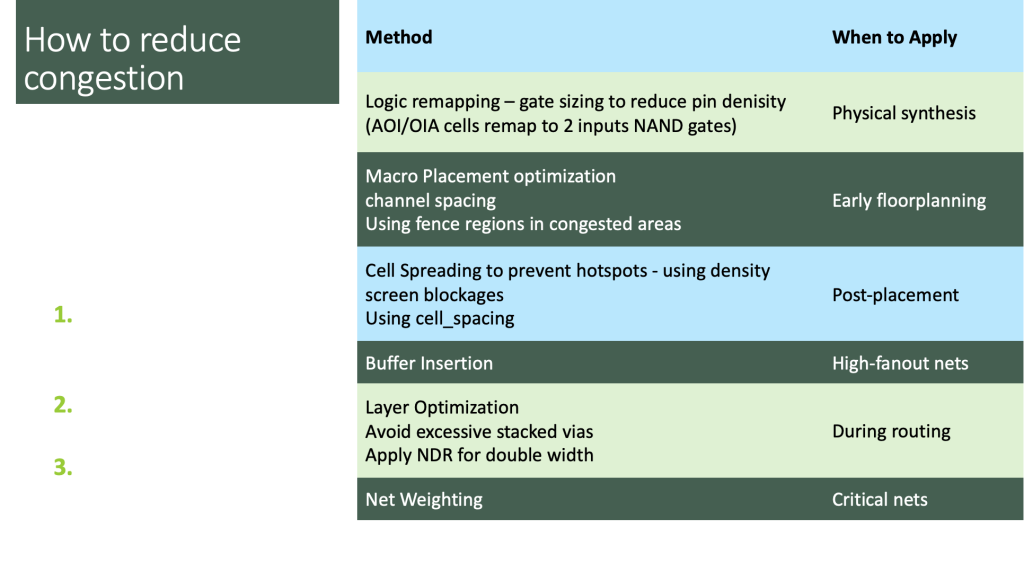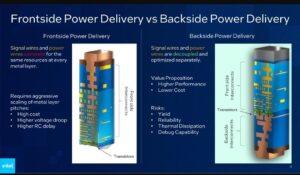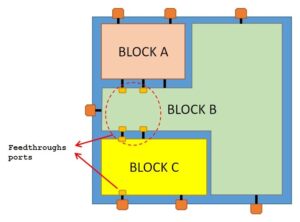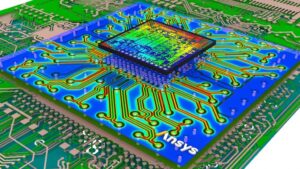In ASIC physical design, congestion occurs when there are more routing demands than available resources (tracks) in a region, leading to routing failures, increased delays, and DRC violations. Managing congestion is crucial for achieving a routable design with optimal performance.

Methods to Reduce Congestion

1. Floorplanning Techniques
Macro Placement Optimization
-
- Place large macros (RAMs, CPUs) at the periphery to free up routing channels.
-
- Avoid placing macros in high-density standard cell regions.
-
- Use channel spacing between macros for smoother routing.
Power Grid Planning
-
- Avoid overly dense power stripes that block routing tracks.
-
- Use staggered power stripes instead of continuous ones.
Hierarchical Floorplanning (Block-Level)
-
- Divide the design into sub-blocks with controlled interconnect density.
-
- Use fence regions to restrict cell placement near congested areas.
2. Placement Optimization
Cell Spreading
-
- Increase cell spacing in congested regions (e.g.,
setPlaceMode -place_global_cell_spacingin Cadence Innovus).
- Increase cell spacing in congested regions (e.g.,
-
- Use density screens (
-uniformDensity) to prevent hot spots.
- Use density screens (
- Utilization Control
Keep standard cell utilization ≤ 70-80% in congested areas.
-
- Use partial placement blockage to restrict cell density.
Congestion-Driven Placement
-
- Run global placement with congestion awareness (e.g.,
-timingDriven -congEffort high).
- Run global placement with congestion awareness (e.g.,
-
- Use ECO placement to redistribute cells post-optimization.
3. Routing Strategies
Layer Assignment
-
- Route local nets on lower metals (M1-M3) and global nets on higher metals (M4+).
- Avoid excessive via stacking in dense regions.
Track Utilization Balancing
-
- Use alternate routing directions (e.g., M1: Horizontal, M2: Vertical).
-
- Avoid routing bottlenecks by spreading signals across layers.
Non-Default Rules (NDR)
-
- Use double-width spacing for critical nets to reduce conflicts.
-
- Apply shielding for noise-sensitive nets to prevent detours.
4. Logic & Netlist Optimizations
Buffer & Inserter (Buf/Inv) Tree Balancing
-
- Reduce fanout congestion by inserting buffers in high-fanout nets.
-
- Use clock tree synthesis (CTS) optimizations to minimize skew-induced congestion.
Logic Restructuring
-
- Replicate high-fanout cells to distribute load.
-
- Split long wires with repeaters to reduce routing pressure.
Net Weighting
-
- Assign higher priority to timing-critical nets (
setNetWeight).
- Assign higher priority to timing-critical nets (
5. Physical Synthesis & ECO Fixes
Congestion-Aware Synthesis
-
- Use physical synthesis tools (e.g., Fusion Compiler, Genus iSpatial) to optimize for routability.
-
- Apply gate sizing to reduce cell density.
-
- Post-Route ECOs
-
- Perform minor placement legalization to relieve congestion.
-
- Reroute problematic nets with manual guidance.
6. Advanced Techniques
Pin Access Optimization
-
- Use offset pins or middle-of-line (MOL) routing to ease pin access.
-
- Avoid pin congestion by spreading pins in macros.
DFM (Design for Manufacturability) Adjustments
-
- Follow metal density rules to avoid CMP (Chemical Mechanical Polishing) issues.
-
- Use fill cells to maintain uniform density.
Congestion Analysis & Debugging
Early-Stage Checks:
-
- Use global routing congestion maps (e.g., in Innovus, ICC2).
-
- Identify hotspots (red/yellow zones) in congestion reports.
Metrics to Monitor:
-
- Overflow (%): Percentage of unroutable nets.
-
- Cell Density: Should be < 80% in most regions.
-
- Track Utilization: Should not exceed 90%.
Common Fixes:
-
- If congestion is localized: Adjust placement, add routing blockages.
-
- If global: Reduce utilization, optimize netlist.

Example Flow for Congestion Reduction
-
- Initial Floorplan → Identify congestion hotspots.
-
- Adjust Macro Placement → Free up routing channels.
-
- Run Congestion-Aware Placement → Spread cells uniformly.
-
- Optimize Power Grid → Avoid blocking routing tracks.
-
- Rerun Routing & Verify → Check overflow reduction.
Summary
| Method | When to Apply | Impact |
|---|---|---|
| Macro Placement | Early floorplanning | High (reduces routing blocks) |
| Cell Spreading | Post-placement | Medium (improves track usage) |
| Buffer Insertion | High-fanout nets | Medium (reduces net crowding) |
| Layer Optimization | During routing | High (better resource usage) |
| Net Weighting | Critical nets | Low (prioritizes key routes) |
Final Tip: Use iterative refinement—congestion fixes often require multiple placement/routing trials.





